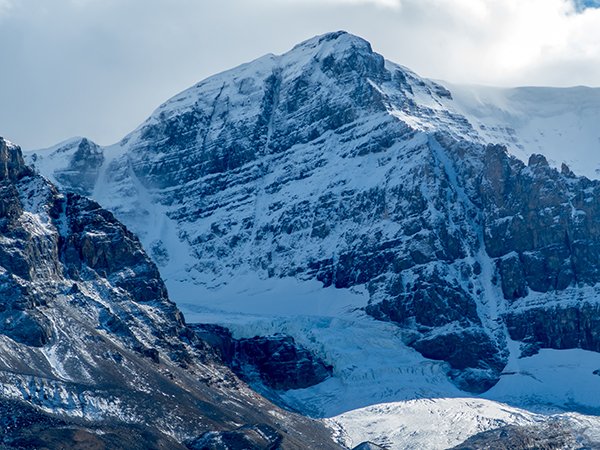Review by Levi Kettner
It’s 2017, and my climbing partner and I are somewhere between the parking lot and summit of Mount Athabasca. We fidget in the dim light of our headlamps, a ritual of untangling kinks and tying knots, as we ready to clamber onto the toe of the AA col’s glacier. We take our time, waiting for the dawning light to rise above the eastern skyline.

Eventually, it does. And before the sunrise uncovers the hidden cracks of the late summer ice-flow, its yellow light streaks across the headwall to the west of our hanging valley. Though our route turns into the shadows and rambles up an easy low-angled gully, we gaze up at the towering rock formation in the sunlight. Etched within this ancient limestone is the Andromeda Strain: a 600-metre climbing route that carves through the meandering rock bands, exposed ice runnels, and overhanging snow mushrooms, all the way to the rounded peak of Mount Andromeda. For an alpine climber in the Canadian Rockies, climbing the A-Strain is like competing in the Superbowl—except a mistake would result in a 600-yard freefall instead of a 10-yard penalty.
Stunned by the grandiosity of the line, we trace our eyes up the route and picture the unimaginable feat that a Canadian climber, the late Marc-Andre Leclerc, accomplished the preceding spring: He had climbed the Andromeda Strain, solo—accompanied by neither belayer nor photographer—and completed the route without having ever rehearsed it. But what was most incredible: Leclerc had soloed the route as a “warm-up”, preparing to tackle the tallest mountain in the Canadian Rockies, Mount Robson, in a style that was entirely his own.
A new documentary on Amazon Prime Video, The Alpinist, looks at the life of the charismatic, yet often socially awkward, young climber. The film follows Leclerc on his renowned ascents through Squamish, the Icefields Parkway, and Patagonia as Peter Mortimer and Nick Rosen, the directors, are challenged by the task of filming a man possessed by the flames of adventure.
The production for the film began early in Marc-Andre’s career as a sponsored climber, when he was still a relatively unknown athlete unaccustomed to any sort of spotlight, and continued through to his tragic death in 2018 while climbing in Alaska. Although the crew was not filming him at the time of the accident, the movie shows footage of the search and rescue operation, including heartbreaking interviews with Marc-Andre’s girlfriend and fellow-professional climber, Brette Harrington. Unfortunately, like many in the genre, the film ends in tragedy; nevertheless, The Alpinist is a celebration of Leclerc’s life.
By interweaving the story with action footage, the film adopts the typical format of most modern climbing films. It covers Leclerc’s childhood, where he is unable to stay still within the walls of the classroom and shows his progression into one of the boldest alpine climbers of his generation. There are interviews and voiceovers from an assortment of famed athletes throughout the film, including Will Gadd, Raphael Slawinski, and Barry Blanchard—all local climbers from our Bow Valley.
Paralleling the footage of these ascents are the difficulties of filming a man like Leclerc who, as Brette Harrington aptly says, “is too busy climbing”. At first, I was surprised that the directors chose to include this narrative in the film; the movie comes close to presenting the filmmakers like kids with insect nets trying desperately to capture a free, colourful butterfly for a science project. But choosing to include this part does show how unusual Marc-Andre was as a climber and public figure. In an industry dominated by sponsorships, movie deals, and social media, Leclerc never submitted to these external pressures and continued to pursue his passion in his own manner—often choosing to report his first ascents in small, personal blogs rather than in the videos and sites of his sponsors.
The cinematography of The Alpinist is simply stunning. Jonathan Griffith, Brett Lowell, and Austin Siadak manage to accurately capture the heart-stopping exposure of the climbs with their camerawork—which is no easy feat, even on the steep terrain where Marc-Andre spends most of his time. As someone interested in climbing photography, the shots frequently baffled me: How did they get that shot? Are they on a rope or a well-placed drone? And, more importantly, How the hell did the camera crew get down? The logistics behind planning a shoot of such an impressive athlete, in such inaccessible terrain, truly deserves recognition and credit.
In a scene near the film’s beginning, Marc-Andre is shown free soloing up a mixed route (a climb composed of both rock and ice) on the Stanley Headwall. He works like an artist, slow and methodical, resting every delicate placement of his crampons and tools within the cracks and features of the overhanging rock. An unknown distance below him, a faint approach trail is marked in the snow, but Leclerc never looks downwards. He holds the composure and steadiness that a climber twice his age couldn’t show while attached to a rope. Every moment, I was waiting for a slip—to hear the chalkboard scrape of steel against limestone. But each movement is executed in perfection. This is the first time that I have found a climbing scene genuinely hard to watch—which, I believe, speaks highly of the cinematography and the athlete.
There are certain things I wish the documentary did differently. Since the recent success of climbing films in mainstream television, I tend to approach new outdoor documentaries with skepticism. Recent well-known movies like The Dawn Wall and Free Solo (the latter won the academy award for best documentary feature in 2019) tend to sacrifice the technical aspects of the sport for mainstream digestibility.
Unfortunately, The Alpinist follows suit. Most of the routes shown in the film go unnamed, while their grades are never mentioned. I can understand leaving out the grades: After all, would the film’s targeted audience understand what “Infinite Patience VI WI5 M5 5.9” means? Probably not—at least not without a few diagrams and a couple history lessons. Still, I think including route grades on-screen could satisfy those curious.
Regardless, I wish more attention and time were spent covering the routes. Every alpine route has its own history, story, and life. To gloss over this knowledge is to fail to understand the major contributions that Marc-Andre has built onto their legacies. I don’t think The Alpinist needs to fulfill the niche market that the Master of Stone or Inertia series occupies, but it would be welcoming if the mainstream climbing media finally found a way to present the technical aspects of the sport in an accessible manner. For those interested, Meru—a 2015 film also available on Amazon Prime—is a good example of an alpine climbing documentary that finds this middle ground.
The film also seems to glance over a vital part of Marc-Andre’s story. In a blog post written about his solo of Mount Robson’s Emperor Face, Leclerc writes that most people are “afraid to confront [their] own personalities” and become “actors . . . rather than living as who [they] are”. For Marc-Andre, experiencing nature was the only way to combat this problem. Soloing big routes, it seems, was Leclerc’s existential crusade against life as a staged performance. Climbing provided a reduction to elemental simplicity—a confrontation with a naked self. It was an opportunity to learn and grow. As it aims to appeal to a broad audience, the movie underplays this spiritual, or transcendental, aspect of Marc-Andre’s climbing.
To be fair, the gripes I have with this movie are the contentions I have with the industry standard. This film is paired next to Meru as what I believe to be one of the best climbing documentaries of the last ten years. Does the movie do justice in representing Marc-Andre Leclerc’s life and accomplishments? No—that’d be impossible. Does it provide a brief glimpse of his daring climbs, love of life, and unfailing passion? Absolutely. Watching the film brought me back to my time as a young climber when I would read Marc-Andre’s most recent blog post, simply transfixed that there was a man out there making impossibilities reality.
Although I will likely never swing into the ice of the Andromeda Strain, the inspiration and awe of Marc-Andre’s life is simply unforgettable. Because of films like The Alpinist, I will always look up from the paths of gentle ridges, as my partner and I did in 2017, and be mesmerized by the figures of the past, who represent so much of alpinism’s future.
The Alpinist is available for streaming on Amazon Prime

